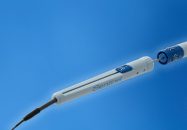Certain studies have carried out a tomographic follow-up of patients who underwent transcatheter aortic valve replacement (TAVR) and described the frequency of leaflet thrombosis; however, in most cases, it is unclear whether this finding requires some sort of intervention. The difference between this work and those previously published is that this study is not focused on imaging, it…
SENTINEL study: cerebral protection during TAVR
Neurological complications during and after transcatheter aortic valve replacement (TAVR) are probably the only event whose incidence has not been reduced by new valve designs (as opposed to paravalvular leak, vascular complications, or need for pacemaker implantation). Aside from the potential seriousness of this clinical event, the risk of embolism is particularly worrisome because,…
[SURTAVI] Sub-study of neurological events: more evidence in favor of TAVR
Courtesy of SBHCI. The occurrence of a periprocedural neurological events is associated to an increased risk of death and morbidity at long term, both for transcatheter aortic valve replacement (TAVR) and for surgery. The SURTAVI study, recently presented at the ACC meeting and simultaneously published by NEJM, showed that TAVR with self-expandable CoreValve or Evolut…
NOTION: TAVI with low risk at 4 year follow up
Courtesy of the SBHCI. There is little data about the use of transcatheter aortic valve replacement (TAVR) to treat patients with severe aortic stenosis at low surgical risk. Many of the questions involve long term duration of valves (over 10 years) when treating younger patients with longer life expectancy. The NOTION study aims at comparing…
ARTE: Aspirin or Aspirin and Clopidogrel after TAVR?
Courtesy of SBHCI. This study presented at Euro PCR and simultaneously published by JACC Cardiovascular Interventions poses a question that has remained unanswered since the start of TAVR. There is little information on the optimal antithrombotic therapy after transcatheter aortic valve replacement (TAVR). In general, patients receive between 1 and 6 months of dual…
Diastolic Dysfunction: Shall We Begin to Assess It?
Courtesy of Dr. Carlos Fava. The association between diastolic dysfunction (DD) and aortic insufficiency (AI) after transcatheter aortic valve replacement (TAVR) has not been studied yet, but the presence of aortic regurgitation has proved to be associated with worse outcomes. A total of 144 out of 195 patients who underwent TAVR with balloon-expandable SAPIENS or SAPIENS XT…
Cardiovascular MR Perfusion Imaging: Good Initial Alternative in Stable Chronic Angina
In the initial management of patients with stable chronic angina, a non-invasive strategy with cardiovascular MR perfusion imaging seems to provide similar results to invasive strategies. At one year, MACE rate (combination of all cause death, non-fatal infarction and target vessel revascularization) resulted 3.3% for MRI vs. 3.9% for fractional flow reserve (FFR) informed…
TAVI Frailty Indices: We Should Start Using Them
Courtesy of Dr. Carlos Fava. Frailty should be taken into account when deciding transcatheter aortic valve implantation (TAVI). Even though several scales of frailty are available, they are yet to be tested in this group, with this strategy. The study analyzed 101 patients, frailty was assessed clinically according to the following tests: Katz index…
Pacing with a 0.035” Guidewire, an Old Technique Coming Back to Simplify TAVR
This study seeks to prove the safety and efficacy of rapid left ventricular pacing through a 0.035” guidewire during aortic valvuloplasty and transcatheter aortic valve replacement (TAVR). Right ventricular temporary pacing placed through venous access during aortic valvuloplasty or during TAVR is time-consuming and, above all, associated with cardiac perforation and tamponade. Since…
Cerebral Protection in TAVR: Does It Improve Cognitive Function?
Neurological complications during transcatheter aortic valve replacement (TAVR) may be reduced with cerebral protection devices; this study was designed to explore that hypothesis. The study enrolled 363 patients undergoing TAVR in 19 sites and divided them in three arms: a safety arm (n = 123), a device imaging arm (n = 121), and a non-device imaging arm (n = 119). The…









